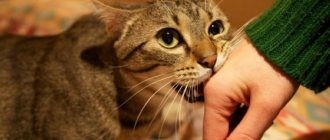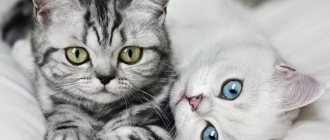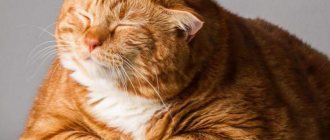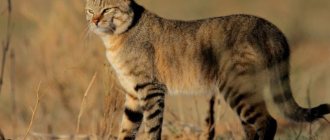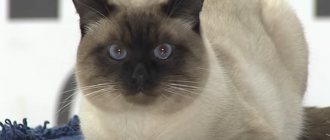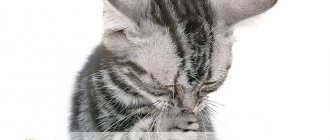How are vibrissae arranged?
Vibrissae are long, coarse hairs that protrude beyond the coat.
Each hair originates from a hair follicle surrounded by nerve endings. This organ of touch is mobile, which is ensured by contraction of the striated muscles. Any, even slight, environmental impact is transmitted to its root and irritates the cells of the nerve endings. The received information is transmitted to the brain and analyzed by the animal.
Each individual has its own area in the sensory region of the brain. The overall picture of the environment is made up of incoming visual and tactile information. At night, the sense of touch has advantages, since it does not depend on external factors.
Vibrissae help determine the distance to an object standing in the way. In the dark, the animal easily bypasses obstacles and rushes at the prey with precision.
This is explained by the fact that objects reflect vibrations and air masses, which are captured by sensitive vibrissae.
It is believed that those located on the sides of the muzzle determine the diameter of the hole into which it is trying to climb. If the animal is overly fat, there is a possibility of getting stuck.
When hunting, a cat relies not only on sight and hearing, but also on touch.
With the help of its whiskers, the animal determines the direction of the wind and searches for a suitable smell.
As a rule, when hunting, a cat moves against the wind to hide its scent and have control over the prey.
Moving ones signal the cat’s mood. A friendly animal spreads its whiskers to the sides and forward, which also shows interest. An aggressive attitude causes the animal to press its whiskers to its head. The vibrissae of an animal at rest are motionless.
If you touch a cat's whiskers while she is sleeping, she will react and open her eyes.
Vibrissae warn the owner of possible danger. Touching branches, grass and walls, they cause a reflex to close an eye or duck. This protects the cat from possible mechanical damage.
In case of hearing or vision loss, the mustache becomes the main source of information.
How to help an animal that has lost its whiskers
Regular whisker loss in cats without an identified cause requires additional examination by a veterinarian. After receiving the results, appropriate treatment methods can be carried out:
- taking anthelmintic and antiparasitic drugs for therapeutic and preventive purposes;
- antihistamines to eliminate allergies and antibiotics to treat infectious diseases;
- vitamins, minerals to strengthen and restore immunity.
Creating favorable living conditions for your pet:
- eliminating excessive dryness in the room when using a humidifier;
- ensuring that bathing is not too frequent and using special shampoos;
- the use of fatty acids (biotin, taurine) in compliance with the dosages prescribed by the veterinarian, since an excess amount of drugs can have the opposite effect;
- eliminating stress factors for your pet;
- use of high-quality animal feed;
- ensuring water balance (regular fluid intake by the cat throughout the day).
Recommendations for eliminating this problem if your cat’s whiskers fall out for various reasons:
- using cheap food for the animal, since such products are of poor quality and can negatively affect the general condition of the pet;
- regular treatment of the coat against parasites, fleas and ticks;
- processing raw meat to destroy helminth eggs that may be contained in it;
- excluding aggression towards the cat from other family members (young children);
- addition of various vitamin complexes to the daily diet of cats;
- regularly providing the required amount of drinking water for the animal, since its lack contributes to the development of urolithiasis and other problems;
- visit the veterinarian at least 2 times a year to assess the general condition of the pet;
- excluding the trimming of whiskers in cats, since even a slight shortening of the length can cause the development of negative consequences.
Whiskers for cats are one of the important organs that provide touch, so their damage becomes the cause of many disorders in the body. Vibrissae require careful care and control on the part of the pet owner to maintain the good condition of the animal.
Functions and structure of vibrissae
With the help of whiskers, the animal receives information about obstacles on the way, about changes in air currents, and thus orients itself in space. Nerve impulses from the whiskers enter the brain along with information from other organs. Therefore, even minor changes in the surrounding space will not go unnoticed by the cat.
Cat whiskers are several times thicker and longer than ordinary hair. Longer and more sensitive vibrissae are located in four rows on both sides of the nose, above the upper lip. The top two rows of whiskers can move independently of the bottom ones. Shorter whiskers are located above the eyes, on the cheeks, on the chin, on the ankles of the front paws, between the pads of the front paws and even on the tail.
The base of a cat's whiskers is located in the superficial layer of the skin. The root of each of them is located in the hair follicle; nerve endings approach it, which transmit information about the environment to the brain.
The structure and location of vibrissae in male cats
Vibrissae are not hairs. They are much thicker, denser and longer. On average, the length of one cat's antennae is five to seven centimeters. Usually the length of the hairs is equal to the width of the cat's body. Unlike wool, “antennas” do not protect the kitty from cold and heat. Vibrissae on the muzzle play a completely different and no less important role.
Each cat's whisker has a curious structure and is connected to a specific part of the cat's brain. Signals received from the antennae allow the pet to formulate a complete picture of what is happening around in its head. So, these hairs consist of several elements - visible and invisible to the eye:
- invisible parts are nerve endings, cutaneous glands and skin;
- the visible part is the vibrissae itself.
The cat's whiskers are mobile due to the connective tissue bag, which contains the hair root, as well as striated muscles. The cat is able to move its antennae, direct them forward or, conversely, press them to its muzzle.
The thickness of a cat's antennae is determined by the many nerve endings and also depends on the sex of the animal. The abundance of nerve endings forms a small tubercle at the base of each hair.
The condition of the whiskers directly depends on the correct care of the pet. Cats that receive the required portion of vitamins, minerals and other beneficial components have “antennae” that are always fuller and longer.
Treatment and prevention methods for mustache problems
Preventive measures against whisker loss and other cat health disorders are as follows:
- reducing indoor air dryness;
- providing the cat with plenty of fluids, a nutritious diet, and taking necessary vitamins;
- timely vaccination, treatment of wool against parasites;
- lack of self-medication;
- creating comfortable living conditions for the cat.
When such measures do not give the desired result and the cat continues to lose whiskers or their condition worsens, it is necessary to contact a veterinarian.
Healthy whiskers provide a cat with a comfortable existence.
The specialist will prescribe tests for the animal, and after studying the results, prescribe a course of treatment. As a rule, the loss of a mustache is a symptom of more serious disorders in the body. The owner’s task in this situation will be to strictly follow the doctor’s recommendations and carry out all necessary medical procedures at home or in a hospital.
Vibrissae are very important for the full existence of cats, because they are an additional organ of touch and allow them to navigate in space, hunt and make precise jumps. Without whiskers, a domestic cat will not die, but its quality of life will be significantly reduced.
Solution
If a cat loses its whiskers, it is necessary to find out the reasons for this phenomenon. In case of mechanical damage, you should try to avoid such situations again. If the issue is poor nutrition, the veterinarian will recommend the optimal food. The problem may also be related to illness. It is necessary to show the cat to a specialist.
Due to the fact that the vibrissae help the pet navigate in space, when deprived of them, it can bump into objects and walk unsteadily in the dark. Therefore, until the whiskers grow back, it is recommended not to let the animal go outside and be extremely attentive to it. Fortunately, if everything is in order with your pet’s health, then the hairs will appear very quickly. The cat will feel confident.
What are vibrissae?
Whiskers are a type of vibrissae, thread-like horny appendages of the epidermis that play the role of special sensory organs. Vibrissae are formed in cats during fetal development and are located on the chin, cheeks, and tips of the ears. The number of whiskers on a cat is 24, 12 on each side.
The color of cats' whiskers is usually white. This is explained by the fact that as the vibrissa grows and moves upward, it loses its coloring pigment - melanin. Although in some cats it persists, and then their whiskers may be black or “highlighted”, black and white, but with age they will turn gray and become colorless.
The vibrissae on the muzzle pads are much thicker and longer than the fur, and are held tighter. Male felines usually have thicker whiskers than females. The length of a cat's whiskers is 6-7 cm, but in some breeds, for example, Maine Coons, they can reach a length of up to 16-18 cm, and in Sphynxes, Cornish Rexes and Devon Rexes the whiskers are curled, like hussars.
Features of a cat's whiskers
Cat whiskers are scientifically called vibrissae. This concept comes from the Latin word “vibrissae”, which can be translated as “vibrate”, “wriggle”, “oscillate”. Indeed, the hairs of the mustache are in constant motion and vibrate. In their structure, the vibrissae resemble ordinary hair, but, in essence, they are sensory organs. They are also called “tactile hairs”. Compared to regular wool, they are much stiffer, thicker, longer and rooted deeper.
Tactile hair has deeper roots than normal hair
Structure and location
The root of the cat's whiskers is located in tissues with many nerve endings that go directly to the vibrissa hair bursa. There is a special area in the animal's brain for each antennae. Therefore, any changes in the environment, be it air vibrations or the appearance and movement of some objects, are directly transmitted to the brain and affect the cat’s behavior.
Vibrissae roots lead to nerve endings and blood vessels
The bulk of the whiskers are located on the animal's muzzle: there are four horizontal rows on both sides of the nose, the average number of whiskers being 24 pieces. The length of one vibrissae is approximately 6–7 cm, but, depending on the breed and individual characteristics of the animal, this figure can vary either up or down.
The longest mustache listed in the Guinness Book of Records was a Maine Coon cat Missy from Finland - as much as 19 centimeters. Representatives of this breed are generally characterized by prominent mustaches. As for ordinary outbred cats with long mustaches, they have always been considered by the people to be the best hunters of mice and rats.
Vibrissae are located not only on the cat’s cheeks, but also above the eyes, on the chin, and even on the paws and tail. These shorter antennae still perform the same tactile function. For example, vibrissae on the paw pads allow the animal to feel the vibration of the floor.
There are also short whiskers located between the pads on the cat's paw.
The whiskers on the forehead, which people mistake for eyebrows, help not only to sense space, but also to protect the most important organ of the animal - the eyes.
Interestingly, the length of the whiskers depends on the thickness of its owner - fat cats always have longer whiskers than thin ones.
Why are vibrissae needed?
Thus, the main vibrissae on the cheeks and additional ones in other places help the cat:
- Navigate by air movements in space, including assessing the appearance and size of surrounding objects, the distance to them, the correspondence of the parameters of the holes into which you want to crawl to the size of your body. Whiskers become especially good helpers in the dark, when the animal’s vision fails. Cats see without light better than people, but still not well enough for full-fledged hunting or active pastime.
- Hunt, because with the help of whiskers you can assess the direction and strength of the wind for jumping, climbing trees, and also control the behavior of the caught prey, which the cat carries in its teeth.
- Express your emotions and mood: in an interested cat, ready for action, the whiskers are widely spaced and slightly tilted forward, while in a frightened or angry cat, they are pressed tightly to the muzzle.
Vibrissae inform the cat whether the prey is still alive and whether it is trying to resist
Is it possible to trim a cat's whiskers?
Vibrissae are renewed in the same way as ordinary hairs: they age, die, fall out, and new ones grow in their place. This process occurs throughout the cat’s life, including in old age. By tracking age-related changes in an animal's whiskers, you can notice that they become thicker, acquire a dark color, and turn gray in old age. The fallen whisker is usually partially colored, quite stiff and has a sharp end. With age, the rate of replacement of old vibrissae with new ones decreases.
The question of whether it is possible to cut whiskers is often of interest to those who, in addition to cats, have active children who use cats as entertainment. Children can cut off the animal's whiskers while playing. The answer is simple and clear - you don’t need to do this! For cats, whiskers are not a decoration, but a means of touch. There is no need to deprive animals of an additional sense organ. The cut whiskers will gradually grow back, but the cat will feel unwell during the “whiskerless” period.
Whiskers are very sensitive, cats can hardly tolerate being touched by humans or other animals.
However, when conducting research, scientists did not spare the poor animals and repeatedly cut off their whiskers, and then observed changes in behavior. Much depends on the character of the cat: some were very lost and scared, while others behaved almost normally. However, all cats had the following problems:
- they began to navigate worse in the dark and bump into objects;
- could not correctly estimate the size of the holes to penetrate them and often got stuck;
- The accuracy of jumps decreased - they missed or did not reach the object they wanted to jump on.
Cats with cut whiskers lose the ability to correctly judge the distance to jump
Of course, nothing particularly terrible will happen to a domestic cat whose whiskers are cut off, because in an apartment it exists in comfortable conditions, and the whiskers will gradually grow back. But a street cat will have more problems, because its life often depends on the accuracy of orientation in space. In any case, you need to try to explain to children that a cat is a living creature, not a toy, and its whiskers cannot be touched without parental permission. As for adults, it is difficult to imagine a reason why they would want to trim a cat's whiskers. Even if there is a reason, it is better not to do this, but to go to an appointment with a veterinarian.
Any cat after cutting off its whiskers may become confused and behave inappropriately: become nervous, timid, clumsy, uncommunicative and passive.
However, there are exceptions to the general mass of mustachioed cats. These are some breeds whose whiskers are missing or look strange. Cats of the Donskoy, St. Petersburg, and Canadian Sphynx breeds often have no whiskers at all. At the same time, they behave absolutely normally, except that they are colder than the others, but that’s another story. Hybrid breeds, such as elves, greyhounds, and bambinos, have very short and sparse, sometimes curled whiskers. Finally, Cornish Rex and other "curly" breeds have whiskers of normal length, but curled into a spiral.
Sphynxes have no mustaches at all or only grow in small numbers.
Video: what happens if you cut a cat's whiskers
Causes of mustache loss
If you notice a cat's whiskers falling out, there is no need to panic. This is normal: old mustaches die off and new ones grow in their place. But if the pet suddenly began to lose whiskers, and new ones never appeared, this indicates a serious malfunction in the body.
Lack of vitamins in the body
Vibrissae begin to fall out when the cat’s diet lacks vitamins A, D, collagen and taurine, and certain microelements. With a lack of these beneficial substances, the disease can be accompanied not only by loss of whiskers, but also by hair, bad breath, and poor condition of the claws.
Lightened and falling out whiskers may indicate the presence of worms in the animal.
Thyroid problems
Disturbances in the functioning of the thyroid gland, deficiency or excess of its hormones also lead to loss of mustache. These problems are most common in older cats.
Additional symptoms are diarrhea and vomiting, constipation. If these signs are present, you should immediately contact a specialist who will prescribe a course of treatment. Self-medication will only worsen your pet's condition.
Skin diseases
Bacterial and infectious diseases can cause itching and irritation in your cat. The reason for this may be injuries, scratches, cuts.
Severe itching, weakness and loss of appetite appear.
Allergy
Due to food allergies, cats may experience hair and whisker loss. To stop this, you need to find out what product is causing your pet’s allergy and eliminate it from the diet.
If your cat has problems with its whiskers, pay attention to:
- Air humidity in a house or apartment;
- Availability of a bowl of water. Mustaches can fall out due to dehydration;
- Quality of animal feed. It must contain natural ingredients, be balanced and not have harmful additives;
- Bathing mode. It is enough to wash the cat once every 3 months;
- Hairless breeds require frequent bathing - once every two weeks in the spring and every month in the winter. The cause of mustache loss can also be the wrong shampoo;
- Time of year and puberty.
If you do not fight the loss of whiskers, this will lead to the pet becoming confused, fearful, and unable to navigate the area, even if it is an apartment in which he has lived his whole life. And on the street such a cat has a negligible chance of survival.
Mustache fragility. What to do?
Having received the answer to the question of why a cat needs a mustache, you can understand how important they are for a small predator. However, the animal's whiskers can break. If the hair follicle has not been damaged, the mustache can regenerate. Sometimes the damage is accidental. Systematic damage and loss of mustaches can be caused by the following factors:
- Improper diet, due to which the cat’s body is deficient in calcium and other vitamins.
- The appearance of worms that eat beneficial substances, which is why the animal also lacks calcium and other substances.
- Fungal diseases.
A veterinary clinic specialist will help determine the true cause of injury and whisker loss. He will also prescribe the necessary course of treatment and offer a diet rich in vitamins and minerals.
Functions of vibrissae
The scientific name of such a sensory organ is vibrissae. White whiskers and eyebrows are located near the cat's nose and above the eyes in several rows and will grow on average 7 centimeters in a kitten and curl. The longest recorded specimens measure 19 cm. They grow and renew throughout the pet’s life. Some antennae curl, the color of the pile is usually light. They perform several important functions at once. They, like the tail and teeth, serve as a sense organ for the pet and help to move and navigate in space. So, with their help, the cat catches wind currents, which allows it to correctly calculate the length of the jump. Therefore, thanks to the whiskers, the animal avoids injury.
The upper and lower whiskers in cats detect the most imperceptible vibrations emanating from objects. Therefore, the animal distinguishes the size of surrounding things, the distance to them, and easily avoids all obstacles in the dark. Since cats are predators by nature, they need whiskers and a tail for hunting. They detect any movement of the victim. When a cat has caught prey, it uses its whiskers to determine whether it is already alive or not. In addition, such senses show the pet whether the food is safe to eat or whether it is unsafe. By the appearance of a cat's whiskers, you can determine the cat's mood: if they are lowered down and pressed to the sea, then the pet is dissatisfied, and if they are raised and placed to the side, this signals a good mood. The tail says a lot about your emotional state.
What is the scientific name for a cat's whiskers?
Whiskers are the common name for the stiff hairs growing on the body of an animal. In fact, their scientific name is vibrissae, which comes from the Latin word vibro. Translated, it means “to waver” or “to wiggle.”
Indeed, the whiskers of cats, even in a calm state, tremble finely, that is, they vibrate. This is clearly noticeable if you look closely at your pet.
As a result of scientific research, it has been established that whiskers appeared on the body of the cat’s ancestors much earlier than they were overgrown with hair. In addition, observing the behavior of individuals helped to find out why the cat needed a mustache. Their presence is the main distinguishing feature of furry mammals.
Is it possible to cut off a cat's whiskers?
A common mistake is that a cat's whiskers should be trimmed at the owner's discretion. Some cats, like the Devon Rex, even have curly whiskers, so you might think it wouldn't hurt to straighten them with a little trim. This is absolutely forbidden to do!
Important! Trimming a cat's whiskers is a big mistake. Without tactile hairs, pets become disoriented and fearful
Why do cats need whiskers?
Vibrissae allow them to assess the situation and analyze the environment. Whiskers do grow, but cats need to keep them intact just as humans need their sense of touch. Scientific experiments conducted by English scientists with cats with shortened whiskers may explain why whiskers are needed. Without them, it is difficult to judge the exact locations of objects in space. Pets often misjudge jumping distances and sometimes collide with things in the way.
A cat without a whisker feels confused
Mustache - a hunter's weapon
So, when discussing the topic “why do cats need whiskers,” we cannot fail to mention that the whiskers are involved in the hunting process. With their help, you can easily recognize even slight movements of prey. The cat is a predatory animal and prefers the dark time of day for hunting. The whiskers allow you to obtain the necessary data about your future victim and, with the necessary accuracy, perform a lightning-fast striking jump that will not leave the prey the slightest chance of salvation.
Everyone knows that a cat can rid a house of rats, mice and other small rodents. When an animal, having caught prey, carries it in its teeth, the tips of the whiskers control the state of the victim (whether it is killed, or attempts of resistance on its part are still possible).
Can cats' whiskers be trimmed?
In case of emergency, veterinarians are sometimes forced to trim the cat's whiskers in order to get to the source of inflammation. But do cats grow whiskers? Yes, and they grow three times faster than regular wool. But there is no need to cut them on purpose, because this is a huge stress for the animal: loss of self-confidence, poor spatial orientation and fear. In other words, trimming an animal’s whiskers is strictly prohibited unless this is a necessary action that the veterinarian advises to do.
It is necessary to understand when a cat’s whisker has fallen out and when it has simply broken. If the tendril has fallen out, then its tip has an oval (onion), if the tendril has broken off, then its base is slightly beveled. If this phenomenon is constant, and the cat’s whiskers constantly break, fall out or split, then you need to consult a doctor for help so that he can prescribe treatment. It is possible that the animal simply lacks some trace element or vitamins in the body.
Functions of the mustache
We all know that a cat's whiskers are the same as a person's nose. But, besides smell, they also perform other functions. Let's find out why else a cat needs a mustache.
Hunting
Tactile sensations are very important for a cat when tracking down prey. This is where the vibrissae help him - when they touch the ground, he feels any minor vibrations, even from the tiny paws of a mouse.
Find out how to choose cat litter, how to train a cat to use a litter box, how to wash a cat without scratching, whether a cat needs to be trimmed, how to get rid of the smell of cat urine, what a furminator is and grooming.
It turns out that cat whiskers are a device that determines the safety of food. Even a domestic cat, having received treats, first stretches its antennae forward to understand whether the contents of the bowl are dangerous: instincts, nothing can be done.
Important! Having lost his antennae, the cat has to be extremely careful: touch food with his paw, move the bowl, stomp around it. This leads not only to a loss of confidence, but sometimes to more serious changes in the animal’s behavior.
Orientation
Sometimes owners don't understand why their cat's whiskers are falling out. One of the reasons is their constant use as a “navigator”.
Moving in the dark, the cat bends its muzzle so that its antennae touch the surface - the ground, grass, wood. The mustache helps her overcome obstacles and navigate correctly even in pitch darkness.
Therefore, if the pet is active, often walks, or lives in a village without street lighting, the whiskers quickly wear out and break off.
Communication
You can tell your pet's mood by looking at a cat's whiskers. Mustache forward - “I’m not against communication.” They puff up in different directions - “I’m evil, don’t touch me.” But sometimes cats fluff out their antennae when playing.
The mustache is pressed to the muzzle - “Fuck off, no time for you.” True, the cat also presses them if he is scared or does not like the person/animal. Therefore, look for other signs as well.
You will probably be interested in reading about which cat breed is the smartest, how a flea and tick collar works, how to deliver a cat, how to care for a cat after sterilization, what a cat purr means, how to get rid of dandruff in a cat and how to make toys for a cat with your own hands.
Is it possible to remove cats' whiskers?
It often happens that cat owners, out of ignorance or “for the sake of beauty,” remove their pet’s whiskers. Sometimes a small child performs this action for fun, playing with the “kitty” and deciding to trim its mustache.
Doing this without a veterinarian’s prescription is strictly prohibited (the previous paragraph describes in detail what happens to a cat that has lost tactile hairs). Sometimes, due to any injuries or wounds, a cat’s whiskers are deliberately removed at a veterinary clinic.
. But they do this only if the vibrissae are located directly on the affected area. In other situations, veterinarians never trim a cat’s whiskers and do not recommend that its owners do so.
Life without a mustache
Cats are very curious animals. They can watch a lit candle or stove. Investigating these phenomena can damage the mustache. Sometimes children play with cats and trim their whiskers. If this happens, the cat becomes completely helpless. It is difficult for her to navigate in space, she becomes simply unhappy.
Sometimes, due to its curiosity, a cat may be left without a whisker.
Sense organ
We have learned since childhood that a person has developed 5 senses, which correspond to a certain part of the body. The animals are luckier. To the standard sense organs, an additional one is added, which is very important - the mustache. Not many people know what a cat's whiskers are called. Experts gave them a definition - vibrissae. The word comes from the Latin name vibrissae, which means “vibration”.
Whiskers are long hairs located near the animal's nose. They are quite rigid, but can break off. If the animal's fur provides thermal insulation, then the additional sense organ is directly connected to the nervous system and performs a tactile function.
Sense organ
We have learned since childhood that a person has developed 5 sense organs, which correspond to a certain part of the body. The animals are luckier. To the standard sense organs, an additional one is added, which is very important - the mustache. Not many people know what a cat's whiskers are called. Experts gave them a definition - vibrissae. The word comes from the Latin name vibrissae, which means “vibration”.
Whiskers are long hairs located near the animal's nose. They are quite rigid, but can break off. If the animal's fur provides thermal insulation, then the additional sense organ is directly connected to the nervous system and performs a tactile function.
Why does a cat need a mustache?
A kitten without a whisker loses orientation in space
Vibrissae are the sixth sense organ directly connected to the brain. With their help, life is regulated: from touch to communication with furry fellows. If you don’t know why cats absolutely cannot have their whiskers cut, you can seriously harm them. Whiskers are not ordinary fur, and their loss deprives the pet of the opportunity to safely walk down the street, explore unfamiliar types of food, or hunt.
A kitten without whiskers loses orientation in space Vibrissae are multifunctional devices designed by nature as an additional sensory organ. They help cats hunt. A running mouse creates air vibrations that are instantly picked up by a small predator. The pet determines:
- the exact location of your victim;
- her condition;
- the point to which the enemy moves.
After capturing the mouse, the hairs growing on the cat's front paws come to the rescue. With their help, she controls the behavior of the victim, assesses the situation, determines the location and strength of resistance of the rodent or bird.
When communicating with fellow creatures, the mustache plays a big role. An animal’s reaction to the appearance of an unfamiliar individual or person can be determined by the position of its whiskers:
- If they are aimed at the subject of study, then the pet is interested in communication, it emanates friendliness.
- If they are pressed together with the ears, then attempts to pet the cat will lead to scratches, bites and the rapid disappearance of an aggressive animal.
Important! Vibrissae are the first to form during the embryonic development of babies. They help the newborn quickly establish contact with the outside world, identify the mother and brothers
It’s better not to even think about what will happen if a newborn cat’s whiskers are trimmed. You should not do this, because until they are restored the baby will be deaf and blind and will be afraid to move.
Difference from hairs
The physiological characteristics of vibrissae include their deep insertion into the skin. Each of the antennae is a kind of antenna, surrounded by many nerve endings. They are used to transmit received signals to the brain center.
Vibrissae are complex receptors equipped with muscle fibers. They are responsible for the sense of touch, and their appearance is associated with evolutionary changes in the furry pet’s body. The longest ones are located on top, the shortest ones are located in the chin area. The main help of sensitive antennas is the ability to quickly and silently hunt birds and rodents at night.
Whiskers help cats hunt
Important! By the whiskers you can evaluate the cat's next action. Splayed - intended to intimidate the enemy, directed in the opposite direction - indicate anxiety and uncertainty of the pet
Sensitivity
Resourcefulness and cunning are important character traits not only of an adult, but also of a small kitten. If you cut a cat's whiskers, what will happen to it:
- sensitivity to possible danger will decrease;
- the definition of the road will be lost in complete darkness;
- the reaction to environmental changes will disappear.
Touch is one of the important functions of vibrissae. With its help, pets will find out the safety of the food offered and its freshness. In pitch darkness, the animal easily avoids objects standing in the way by touching them with its whiskers. In some cases, direct contact is not necessary: due to the mobility and vibration of hard hairs, air vibrations are created, the reflection of which from foreign objects is caught by the vibrissae. After transmitting the signal to the brain center, the cat receives a three-dimensional image of space.
If a cat's whiskers are cut off, what will happen to it during a chase:
- she will not be able to determine the diameter of the hole she is going to crawl into;
- may get stuck in it;
- she will not be able to hide from her pursuer.
Important! Veterinarians have noticed that the loss of sensitive hairs for various reasons leads to the development of neuropsychiatric disorders in furry pets. They lose the skills to receive and process information, become defenseless, and behave inappropriately
The main purposes of a cat's whiskers
Cat owners need to remember that the whiskers are a separate sensory organ for your pet, which not only helps them navigate the area, but also communicate both with people and with each other. And this body performs several functions:
Mustache as an organ of touch
Whiskers are a cat's sense of smell. With the help of its whiskers, a cat determines the freshness and quality of food and water.
Navigation task
Everyone knows that cats can move silently in complete silence and darkness. It turns out that she can do this only thanks to the vibrissae.
Vibrissae are incredibly sensitive. They capture air currents that are reflected from objects standing nearby. This is what helps the cat determine the location of objects and avoid obstacles even in complete darkness. Nerve impulses from the vibrissa enter the animal’s brain in the same way as from the eyes. The brain adds signals received from the eyes and vibrissa and creates a three-dimensional picture of the environment.
Protective function
If you touch the whiskers, the cat will close its eyes. When hunting, this is a very important reflex for a predator, which sneaks up on prey without taking its eyes off it and at the same time overcomes obstacles: bushes, fences, or crawls into narrow holes. When hunting, the cat's whiskers are extended forward, with their help it catches the slightest rustle.
Whiskers for hunting
Whiskers help a cat hunt. With the help of whiskers, the cat easily determines the location of the victim, the direction of its movement, as well as its condition. When prey is caught and the cat does not see it because it is held in its teeth, the whiskers help control how the prey behaves.
Vibrissae also help the cat during hunting.
Mustache as an aid in communication
When communicating with your cat, you should pay attention to the position of its whiskers; they will tell you what mood your pet is in.
- If the presence of a person arouses interest in the animal, then the cat's whiskers will be directed forward. This is a hint that the cat is interested in you and is studying you.
- If an animal has pressed its whiskers together with its ears, then such a cat should not be stroked. She is scared or aggressive.
Vibrissae on a cat's body help it determine how someone touched the cat and whether this contact was pleasant. When you stroke a cat's fur, the cat finds this contact pleasant. But if you stroke the cat against the grain, this will irritate the whiskers. And such contact will be unpleasant for the cat.
What are the dangers of mustache loss?
The causes of whisker loss in cats have long been of concern to owners and veterinarians, but this issue has not yet been fully studied. It often happens that several cats living together pull out each other's whiskers. They do this secretly from the owners, so the owners often do not understand why the pet’s whiskers fall out and drag the beardless pet to the doctors. The version proposed by scientists suggests that in this way the animals are trying to subjugate their neighbor, whom they consider a competitor. Without a mustache, a competitor feels insecure and restless, and such a roommate is much easier to dominate, and he will snap back less.
Why you shouldn't trim your cat's whiskers
What happens if you trim a cat's whiskers? Often our pets are injured after an unsuccessful jump or a fight with a relative. With deep wounds on the face, veterinarians are forced to remove the hair along with the antennae in order to be able to treat the injured area. After shaving, cats' whiskers grow back faster than fur, which once again proves to us how necessary they are for the animal. It is absolutely forbidden to trim your pet's mustache!
The loss of whiskers is a very serious and difficult test for a cat, since without whiskers it loses the ability to navigate in space, hunt and check its food. This undermines self-confidence and the pet may become depressed, inactive and constantly in a bad mood.
Now you know how cats react to the loss of their whiskers, and they should not be cut. While the animal is waiting for the whiskers to grow, it is in constant anxiety and stress.
To find out why cats need whiskers, ethologists conducted hardware studies. They removed a pair of kittens' whiskers and observed the animals' behavior and changes in their brains. So scientists found out that if, after removal, a new whisker did not grow back for some reason, then the adjacent section of the muzzle with the vibrissae adjacent to it took over its functions. This once again proves how important such an organ is for cats.
Cats' whiskers, like their fur, have their own lifespan. Over time, they wear out and can no longer perform their functions. Mustache loss is an absolutely normal process; one or a pair of lost mustaches does not indicate deterioration in health or lack of vitamins. If the old whisker falls out, then in its place a new, young whisker is already growing to replace it.
It is important for cat owners to be able to distinguish when the whiskers have simply shed and when they are broken. The fallen vibrissae has a bulb at its end - a thickening, oval in shape.
If the whisker you found is missing a bulb and the edge has an uneven base, it means that the whisker did not fall out on its own, but broke off. If you notice that your pet's whiskers often break or fall out, contact your veterinarian for help. Perhaps the animal lacks vitamins or has caught some kind of infection.
What happens if you cut off a cat's whiskers?
Acting for scientific purposes, scientists removed the cat's whiskers. This made it possible to clearly demonstrate why a cat needs a mustache. When the vibrissae were removed, the process of orientation, maintaining balance, and assessing space was disrupted.
The final report found that whisker trimming could disrupt the feline's "navigation system," leading to disorientation. All this increases the risk of injury.
Domestic cats that have lost their whiskers will survive this period successfully. With careful attention from the owners, they will safely wait for new ones to grow. Street animals forced to survive may suffer:
- will not be able to protect themselves from injury while running;
- the ability to navigate in the dark will decrease;
- they will not appreciate the size of the narrow opening and may get stuck;
- will not be able to correctly determine the trajectory of the jump;
- may lose balance.
Physiological or mental disorders
The inability to navigate in space has a negative impact on the physiological and mental health of cats. Bumping into objects can cause injury. Hunting at this time becomes problematic, so there will be a problem with food. There may also be problems with coordination and gait. Possible falls from heights.
Disorientation in space is stressful for animals because they feel defenseless. The ability to assess their surroundings is a natural way for them to survive. A cat without a mustache becomes restless, withdrawn, and nervous. Anxiety can develop into long-term depression.
Do cats grow whiskers?
Like all hair, the whiskers in cats tend to change over time. Their change occurs gradually, so it does not cause harm to the animals. Since only the antennae themselves fall out (the follicles remain unharmed), the regrowth of young receptors occurs quite quickly (after 2-3 weeks). In some cases, regrowth occurs more slowly. If the mustache is cut off or damaged (if the follicles are not damaged), complete recovery will also occur over time. Damaged follicles hurt and bleed for some time, hair restoration does not occur.
Mustache loss
Many cat owners worry if they see their pet's whiskers starting to fall out. But when the mustache “wears out”, it falls out on its own, and this is absolutely normal. If you see one or two “shed” whiskers, there should be no cause for concern.
There are three reasons why an animal's whiskers often fall out/break.
Lack of vitamins in the body or lack of any useful product in the diet
This is the least problematic cause of mustache loss. It's worth contacting your veterinarian or first trying to add more nutrients that cats need to your pet's diet.
The appearance of worms in the body
Worms can also cause vibrissae loss. They “kill” nutrients in the cat’s body, which is why the whiskers begin to break. A “cat doctor” will also help determine whether worms are the cause of whisker loss.
Fungal and bacterial infections
The formation of fungus or the occurrence of other bacterial infections is often accompanied by loss of tactile hairs. In such cases, only a veterinarian can prescribe treatment for your pet.
Whiskers, among other things, fall out more often due to the cat's old age (whiskers simply wear out with age). Also, a cat may lose several antennae in a fight or play with other animals. By the way, for the same reasons, tactile hairs can break off (sometimes a short mustache does not grow back to its normal length).
So, the cat's whiskers are a very complex and sensitive organ that helps our pets in many areas of life and performs important functions
That is why it is so important to take care of our pets’ whiskers, make sure that they do not fall out and under no circumstances cut them (and also do not let small children do this). If you follow these simple rules and take care of your furry friends, they will not have any health problems (including whisker loss).
Problems with whiskers in cats
Having understood why a cat needs a mustache, the owner pays attention to their condition. Brittleness or loss of whiskers indicates problems with the pet's health and indicates a low quality of life.
They break down
The fragility of tactile hairs occurs due to an uncomfortable environment. For example, too dry indoor air negatively affects the condition of the organ and leads to its breakage. Brittleness also occurs due to insufficient consumption of fresh water.
You should not bathe your fluffy often. Chlorine in water and chemicals in pet shampoos negatively affect the elasticity of the whiskers.
Normalizing the humidity in the room, as well as constant access to clean drinking water, will help prevent further breakage. To wash your pets, you should use only high-quality products containing natural ingredients.
Fall out on their own
If brittle hairs indicate problems with the environment, then hair loss is a serious reason to think about your pet’s health. In some cases, hair loss indicates a food allergy.
Allergies often occur to whole milk or fish. In addition to the loss of whiskers, the cat begins to lose hair. Digestive problems arise, and tears begin to flow from the eyes of the allergic person. Such symptoms are a signal for the owner to review the animal’s diet. A visit to a veterinary clinic will help identify the allergen.
Loss of whiskers may also indicate vitamin deficiency. The lack of important microelements and vitamins in the diet and the monotony of the diet cause massive hair loss. Knowing why a cat needs a mustache, the owner must provide the animal with all the elements for the proper functioning of the body.
Another cause of loss is infection with intestinal parasites. Intoxication with their waste products affects the penetration of nutrients into the antennae. This provokes the death of the follicle and loss of the vibrissa.
Infection with skin fungus also occurs. Itchy areas appear around the whiskers, which peel off and gradually lose hair. All these problems require timely treatment prescribed by a veterinarian.
Grows slowly and poorly – or not at all
Slow hair growth indicates poor pet health. Short vibrissae indicate a serious lack of vitamins and microelements in the body.
Sometimes slow and poor growth of thick hairs is a sign of a metabolic disorder or a symptom of an endocrine disease. If the addition of a vitamin-mineral complex does not lead to an improvement in the quality of the whiskers, then consultation with a veterinarian is necessary.
